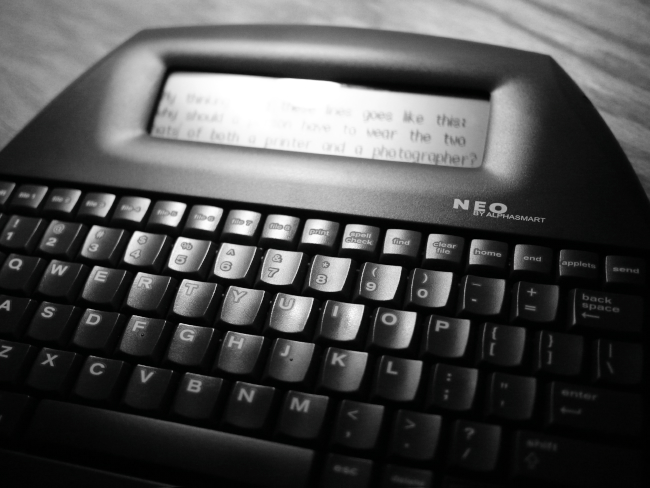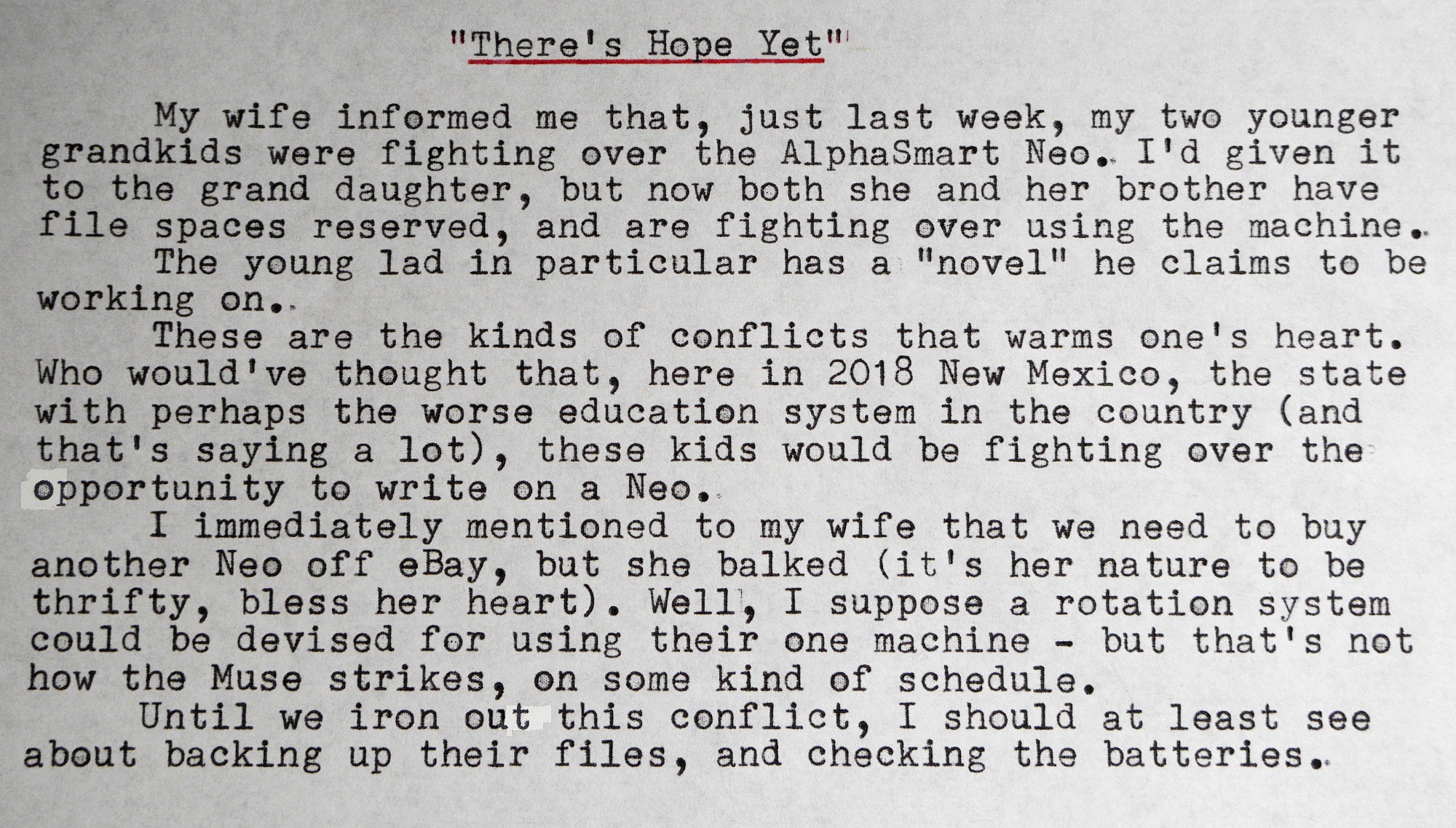There's Hope Yet


Post-Script: On the subject of the AlphaSmart, there's been some discussion recently on the Flickr AlphaSmart forum about alternative devices that offer a similar non-distractive work flow with a great keyboard and battery life. So far, you can't beat a used Neo on eBay (or wherever).
I'm wanting to start making more impromptu blog entries, spur of the moment, off the top (or side, or wherever) of my head. This motivation was prompted by a recent blog entry by Ted Munk, who spoke of the apparent decline of typewriter blogs, from their heyday in the mid- to late-aughts. Part of this is that blogging in general is in decline; but also our attention is being redirected to social media. I wonder also if mobile platforms are just more cumbersome for both consuming and creating blog content.
Whatever the reason, I've decided to get my act together. I know with my focussed concentration on YouTube these last few years, my blog now plays second fiddle. Whereas it once was the primary medium into which my creative thinking was expressed, it's often been used to just advertise a new video over on YouTube; there's rarely new content expressed herein.
There are often little thoughts that break the surface of my consciousness, not big enough to warrant a full-blown (or even half-blown) video production, but something worth tossing into the pond of public discourse in the Typosphere. Little thoughts that might prompt further discussion about things. Or just little observations that might, for no other purpose, serve as entertainment for a few brief moments. These often have been discarded or abandoned. But perhaps they deserve to be preserved here in. The life of the blog doesn't have to be just big articles. There's also little snippets and observations. It is a log, right? A web log.
My older blogging methods were rather meticulous about using a flatbed scanner for type-casts, to eek out the last bit of quality in those images; I've always wanted those images to look like ink on paper, where you see not just black letters floating against a nondescript white background, but you also see the texture, wrinkles and folds of the paper itself. But having to fire up the scanner is often a chore, and chains me to the office computer.
Lately, I've been trying to photograph these pieces, either with the camera in my iOS device, or using a dedicated digital camera. The challenge is always the light, especially evenness of illumination. Even the least bit of shading, from one side to the other, is exaggerated once the levels are tweaked in post-processing. Like today's example; I had flood lamps on either side of the sheet, with a white reflector card helping to even out the exposure. Even so, you can detect that left-to-right shading.
I've decided, on this matter of photographing type-casts, that perfect is the enemy of good enough. It needs to be legible, for certain. Good contrast between the background paper and the ink. It needs to be sharp, both in focus and lack of motion blur. But a bit of geometric distortion (key-stoning, from shooting off-axis; or pincushion) is okay I think. We're not archiving documents for the Library of Congress.
I like more and more the way Ted Munk makes his type-casts, with narrow typed columns and hence large letters on screen. Very legible and readable.
I keep threatening to make a dedicated copy stand for these pieces; perhaps that's the way to go, so I can guarantee even lighting. But would that end up being just as involved as firing up the flatbed scanner? I'd still have to import the images into my computer from the camera and do some post-processing, like levels, rotation and cropping. Well, by using a camera to digitize them, I have the option of not only importing them to my computer but also to my iOS device where I could do the post-process and upload to Flickr, as an alternative method. The only place where the copy stand would be impractical would be blogging while on the road.
Okay, enough about the minutia of the process. What's important is to make the process streamlined, efficient and effortless enough that one (this one) can focus on doing it as often as possible. With results that are "good enough." You might not always like what you read, but hopefully you'll come back more often and visit, to see what I've been up to.
Typecast via Remington Quiet-Riter.
Labels: AlphaSmart Neo, blogging, Remington Quiet-Riter, Ted Munk, typewriter renaissance, Typosphere, You Tube

5 Comments:
I seldom photograph my typecasts, but I do understand the problem with evenly lighting a document. I wonder would a light box work? I had a big one until I moved. Now I do not have one to try. I still use my flatbed scanner.
It'd be nice to somehow invigorate the Typosphere.
Your posts always have shown care, thought, effort, and time. If you want to post some quicker and easier typecasts, go for it—as long as that doesn't go against your personality. That's my 2¢.
I should document my scanning process soon. when I started the OOPRAP project over a year ago, I first had to figure out a process of scanning thousands of pages very quickly, efficiently and cheaply, using a scanner that I could replace easily from a thrift store the same day for under $20 when the old one broke. I settled on a particular brand and model range of stand-alone scanner/printers that required no setup or integration with a computer, and is a popular enough consumer brand with an unreliable/expensive enough print function that it's commonly donated/discarded even with a basically unused scanner function. super-easy to deal with, scans directly to a USB drive.
Yes, I quickly learned that narrow-column typecasts are far more readable, especially on phones, which is where a lot of people consume web content these days. I'm glad you're returning to text blogging. I use a ScanSnap s1300i feed scanner to scan letters and typecasts; it's very small and very quick. I recommend it.
Followup, my scanning process: https://youtu.be/XJQB5slbJKY
Post a Comment
<< Home